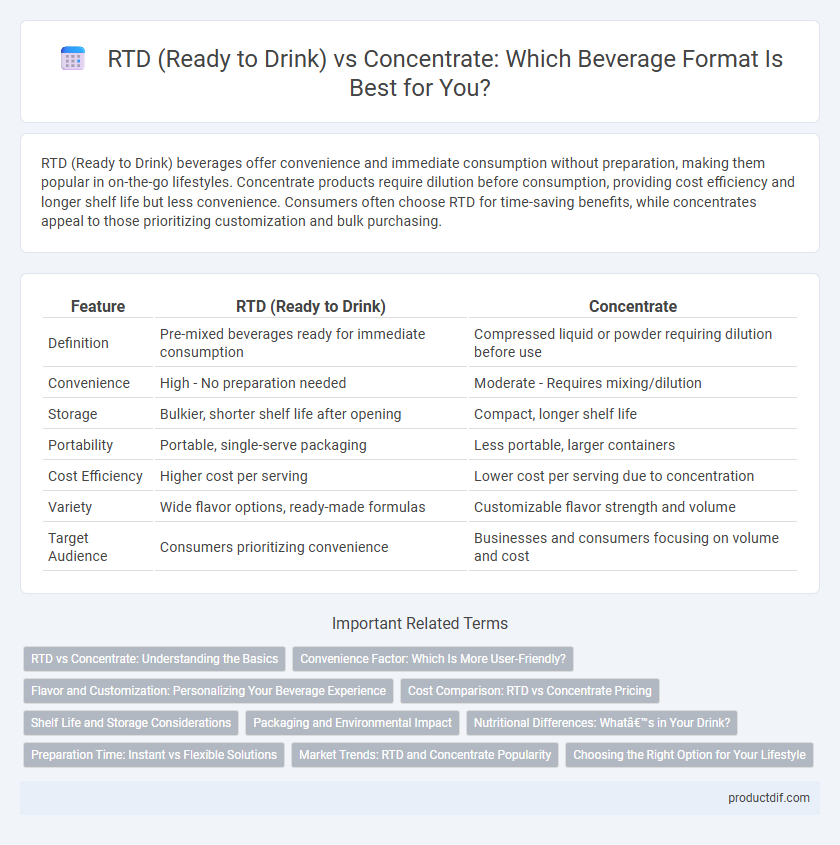RTD (Ready to Drink) beverages offer convenience and immediate consumption without preparation, making them popular in on-the-go lifestyles. Concentrate products require dilution before consumption, providing cost efficiency and longer shelf life but less convenience. Consumers often choose RTD for time-saving benefits, while concentrates appeal to those prioritizing customization and bulk purchasing.
Table of Comparison
| Feature | RTD (Ready to Drink) | Concentrate |
|---|---|---|
| Definition | Pre-mixed beverages ready for immediate consumption | Compressed liquid or powder requiring dilution before use |
| Convenience | High - No preparation needed | Moderate - Requires mixing/dilution |
| Storage | Bulkier, shorter shelf life after opening | Compact, longer shelf life |
| Portability | Portable, single-serve packaging | Less portable, larger containers |
| Cost Efficiency | Higher cost per serving | Lower cost per serving due to concentration |
| Variety | Wide flavor options, ready-made formulas | Customizable flavor strength and volume |
| Target Audience | Consumers prioritizing convenience | Businesses and consumers focusing on volume and cost |
RTD vs Concentrate: Understanding the Basics
RTD beverages offer convenience by providing pre-mixed, ready-to-consume drinks that save preparation time and ensure consistent flavor profiles. Concentrates require dilution before consumption, allowing customizable strength but demanding more effort and precise measurement. Market trends show a growing consumer preference for RTD products due to their portability, shelf stability, and immediate usability.
Convenience Factor: Which Is More User-Friendly?
RTD (Ready to Drink) beverages offer unmatched convenience with pre-mixed portions that require no preparation, making them ideal for on-the-go consumption. Concentrate options demand dilution and measuring, adding extra steps that can be less user-friendly in fast-paced environments. The convenience factor strongly favors RTD products due to their immediate usability and minimal effort required.
Flavor and Customization: Personalizing Your Beverage Experience
RTD beverages offer consistent flavor profiles crafted for immediate consumption, ensuring a reliable taste experience with minimal effort. Concentrates provide enhanced customization opportunities, allowing consumers to adjust sweetness, strength, and flavor intensity to suit individual preferences. This personalization enables a versatile beverage experience tailored to unique taste demands and occasions.
Cost Comparison: RTD vs Concentrate Pricing
RTD beverages typically have higher retail prices due to convenience, packaging, and shelf stability, while concentrates offer a lower cost per serving by requiring dilution before consumption. Concentrate products reduce shipping and storage expenses as they occupy less volume and weight compared to ready-to-drink options. Brands aiming to balance consumer convenience with cost efficiency often price RTDs at a premium, reflecting value-added processing and ready availability.
Shelf Life and Storage Considerations
RTD beverages offer convenient, pre-mixed formulations with a typical shelf life ranging from 6 to 12 months when stored in sealed, refrigerated conditions, ensuring consistent flavor and safety. Concentrates require dilution before consumption and generally have a longer shelf life of up to 18 months, benefiting from smaller packaging and storage in cool, dark environments to prevent quality degradation. Choosing between RTD and concentrate depends on factors like storage space, consumption speed, and preservation preferences in beverage supply chains.
Packaging and Environmental Impact
RTD beverages typically use single-use packaging such as PET bottles or aluminum cans, which offer convenience but contribute to higher waste generation and environmental footprint. Concentrate products are packaged in more compact, lightweight containers, reducing material usage and transportation emissions due to smaller volumes. This packaging efficiency of concentrates leads to decreased landfill impact and lower carbon emissions throughout the supply chain compared to RTD formats.
Nutritional Differences: What’s in Your Drink?
RTD beverages typically offer consistent nutrient profiles with added vitamins and minerals tailored for immediate consumption, while concentrates require dilution and may have variable nutrient density depending on preparation. Concentrates often contain higher sugar levels and preservatives to maintain shelf life, which can affect caloric intake and overall nutritional quality. Consumers seeking convenience may favor RTD for balanced nutrition, whereas those focused on customization should carefully assess ingredient lists and nutritional facts on concentrate labels.
Preparation Time: Instant vs Flexible Solutions
Ready-to-Drink (RTD) beverages offer instant consumption with no preparation time, appealing to consumers seeking convenience and speed. Concentrates require dilution or mixing, providing flexible solutions for tailored flavor intensity and volume, ideal for both home use and commercial settings. The contrasting preparation times influence purchase decisions based on immediate consumption needs versus customizable beverage experiences.
Market Trends: RTD and Concentrate Popularity
Ready-to-Drink (RTD) beverages exhibit rapid market growth driven by convenience and portability, capturing a significant share in the global beverage industry, particularly in segments like tea, coffee, and alcoholic drinks. Concentrate products maintain steady demand due to cost-effectiveness and long shelf life, appealing to bulk consumers and foodservice sectors. Emerging trends indicate RTD's rising popularity in urban markets, while concentrate usage remains strong in developing regions with price-sensitive consumers.
Choosing the Right Option for Your Lifestyle
Choosing between RTD (Ready to Drink) and concentrate beverages depends on your lifestyle needs and convenience preferences. RTD offers immediate consumption with consistent flavor and portion control, ideal for busy individuals seeking easy hydration or refreshment. Concentrate provides customization in flavor intensity and cost efficiency but requires preparation time, suiting those who enjoy tailoring their drinks and prioritizing bulk usage.
RTD (Ready to Drink) vs Concentrate Infographic

 productdif.com
productdif.com